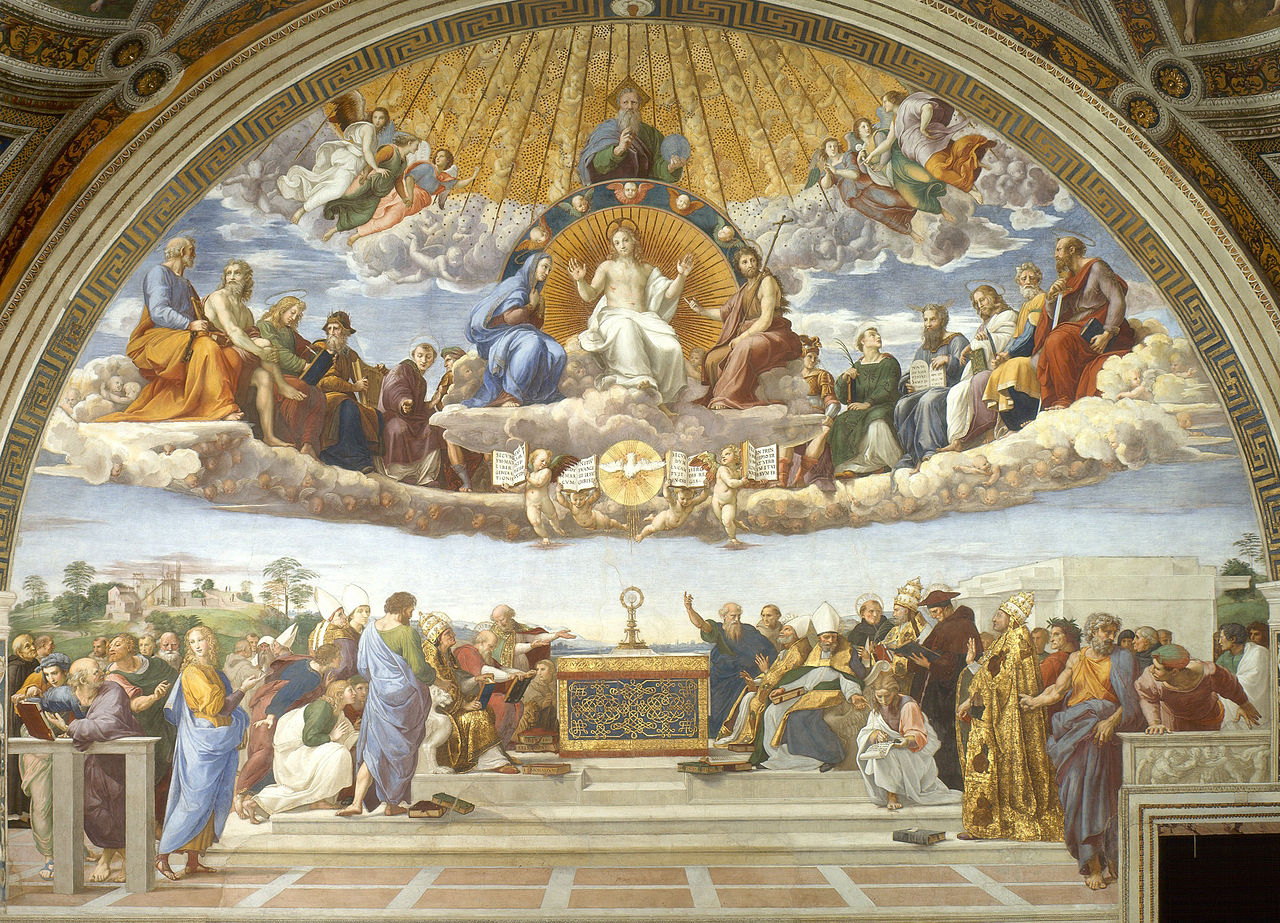Here are important details regarding "The Disputation of the Holy Sacrament" and "Sistine Madonna," both masterpieces from the High Renaissance, painted by Raphael:
The Disputation of the Holy Sacrament (La Disputa)
* Artist: Raphael
* Period: High Renaissance (painted between 1509 and 1511)
* Location: Stanza della Segnatura (Room of the Signatura) in the Vatican's Apostolic Palace, Rome. It is one of four frescoes in the room, opposite "The School of Athens."
* Subject Matter: It is an allegory for Theology, depicting the triumph of Christianity and the mystery of the Eucharist (Holy Sacrament). It showcases the Church's belief in the "Real Presence" of Christ in the Eucharist.
* Composition:
* Two Planes: The fresco is divided into two distinct but connected planes: a heavenly realm (above) and an earthly realm (below).
* Heavenly Realm: At the very top, God the Father presides. Below him is Christ, flanked by the Virgin Mary and John the Baptist, surrounded by a multitude of biblical figures, saints (like St. Peter, Adam, Moses, St. Paul), and angels on a semicircular arrangement of clouds. The Holy Spirit, in the form of a dove, is positioned below Christ, directly above the Eucharist on the altar.
* Earthly Realm: Below, a large gathering of theologians, popes, cardinals, bishops, and other figures (including historical figures like Pope Julius II, Pope Sixtus IV, Savonarola, and Dante Alighieri) are engaged in what appears to be a lively discussion or "disputation" (though it's more about praising God through intellectual engagement). They surround an altar with a monstrance holding the consecrated host.
* Key Themes & Symbolism:
* The Eucharist: The central focus is the Eucharist, representing the true and real presence of Christ.
* Communion of Saints: It illustrates the unity of the Church, both living and "dead" (saints in heaven and theologians on earth), all connected through Christ.
* Divine Truth and Knowledge: It contrasts with "The School of Athens" (representing philosophy/human knowledge) by emphasizing divine revelation and theological wisdom.
* Architectural Integration: Raphael skillfully integrates the figures into the composition to form the "architecture" of the Church itself, united around the Trinity and the Eucharist.
* Artistic Style: Demonstrates Raphael's mastery of High Renaissance principles, including clarity of form, balanced composition, expressive dignity of figures, and dynamic realism in individual poses and gestures.
Sistine Madonna
* Artist: Raphael
* Period: High Renaissance (painted c. 1513–1514)
* Location: Originally commissioned as an altarpiece for the Benedictine convent church of San Sisto in Piacenza, Italy. It is now housed in the Gemäldegalerie Alte Meister (Old Masters Picture Gallery) in Dresden, Germany.
* Subject Matter: A "Sacred Conversation" (Sacra Conversazione) depicting the Virgin Mary holding the Christ Child, flanked by Saint Sixtus and Saint Barbara, with two famous putti (winged cherubs) at the bottom.
* Composition:
* Triangular Arrangement: The main figures of Mary, Christ Child, St. Sixtus, and St. Barbara form a strong pyramidal or triangular composition, characteristic of the High Renaissance.
* Visionary Scene: The figures appear to be emerging from a heavenly realm, suggested by the swirling clouds made of countless indistinct putti heads, and into the earthly space of the viewer. The curtains on either side further frame this transition between divine and earthly.
* Direct Gaze: Mary's direct and intense gaze towards the viewer is notable, inviting the observer into the sacred scene in an unprecedented way for the time.
* The Putti: The two winged putti resting on the balustrade at the bottom have become iconic in art history, known for their contemplative and slightly mischievous expressions. They serve to visually separate the celestial and earthly planes and add depth.
* Key Figures and Symbolism:
* Virgin Mary and Christ Child: Mary carries the Christ Child, stepping forward, with a somewhat melancholic or worried expression, often interpreted as foreknowledge of Christ's future sacrifice.
* Saint Sixtus: On the left, Pope Sixtus II (patron saint of Pope Julius II's family, the Della Rovere) kneels, looking up at Mary and pointing outwards with his right hand, traditionally interpreted as pointing towards a crucifix that would have been placed opposite the painting in its original setting, or towards the congregation. His papal tiara rests on the frame, bridging the pictorial and real space.
* Saint Barbara: On the right, Saint Barbara looks downwards, her gesture and introspective gaze symbolizing inner piety.
* Artistic Style: Exemplifies Raphael's mature High Renaissance style with its harmonious balance, idealized forms, masterful use of chiaroscuro (light and shadow), realistic perspective, and emotional depth. The painting has a sense of effortless grace and serene beauty.
* Impact: The "Sistine Madonna" has had a profound impact on art history and has been widely celebrated, especially in German Romanticism, for its emotional power and spiritual resonance. The putti, in particular, have achieved immense popular recognition.

Comments
Post a Comment